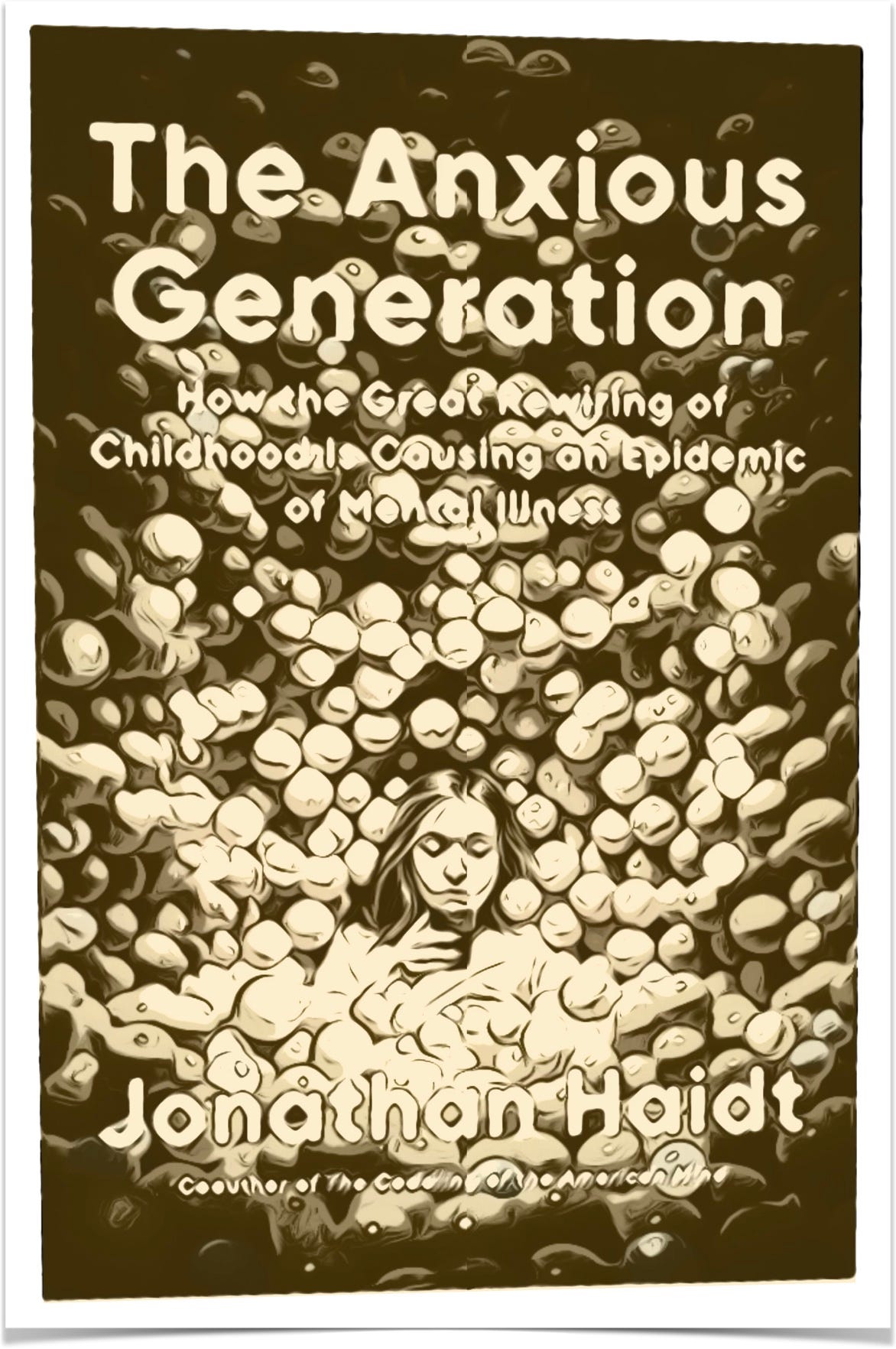The SuperJoost Playlist is a weekly take on gaming, tech, and entertainment by business professor and author, Joost van Dreunen.
Tell me if you’ve heard this one: video games are bad for you.
Jonathan Haidt, in his new book, asserts that video games contribute to social isolation and increased depression, particularly among young men. He connects new technologies to the rise in mental health issues, drawing from diverse data sets and studies.
Haidt's central premise is that video games are a key factor in what he calls the "Great Rewiring of Childhood" that has led to deteriorating mental health among Gen Z. He presents data showing rising rates of anxiety, depression, and ADHD, and argues that this "Anxious Generation" has been uniquely shaped by technological changes, including widespread access to smartphones and immersive online games. Haidt claims that as children's social lives moved online, they became simultaneously overprotected in the real world and underprotected in virtual spaces, leading to developmental deficits and mental health issues.
This debate, however, feels all too familiar.
While the link between violent games and anti-social behavior has diminished over the years (TL;DR there is no demonstrable causality, and gun violence is a uniquely American problem), new concerns have emerged alongside the growing popularity and cultural relevance of video games. Predatory tactics like loot box monetization and extremist recruitment in online games present serious social problems unique to our time, warranting attention.
Haidt introduces mental health issues to this discussion.
Obviously, the book didn’t spawn in a vacuum.
It is entirely fair to ask what the impact of interactive entertainment is on, especially, children. Games like Roblox, Minecraft, and Fortnite are very popular and like to present themselves as the digital equivalent to playgrounds. They are not, however. For one, physical playgrounds are public spaces and not monitored by publicly-traded corporations. And even if we accept that these firms have only the best intentions, it still deserves continued scrutiny and dialogue.
More so, the expanding cultural prominence of interactive entertainment necessitates an ongoing conversation about what it means to play. This dialogue extends beyond entertainment value, shaping novel game design and business model innovation.
Haidt’s argument presents a challenge to anyone involved in the video game industry: Are we, despite offering entertainment and enjoyment, contributing to an apparent epidemic in mental illness?
People do spend more time online playing games. Audiences show a distinct preference for online multiplayer game play. Over the past decade, the combined monthly active user base for the 100 most popular titles shows a doubling for multiplayer titles, from 854 million to 1.6 billion, while single-player games remained flat at 445 million. The free-to-play business model that accompanies most of these experiences relies on positive network effects and gradual monetization. People spend an increasing amount of time online with others in the context of interactive experiences, which is, by all accounts, uncharted territory.
Subsequently, we are also moving into a direction of developing experiences that go well beyond play. Increasingly, major game makers encourage players to make in-game items. Firms like Roblox and Epic Games actively incentivize their players to create content to both strengthen the emotional connection between its audience and the experience, and bolster their respective business models.
Haidt argues that the increasing sophistication and competition for our attention by interactive entertainment is making people depressed. Virtual connections, he argues, create weaker bonds compared to those formed through in-person interactions and shared experiences. In the same way that social media had a demonstrably negative impact on self-image among girls, Haidt says,
“video games made it easier for [boys] to retreat to their bedrooms rather than doing the hard work of maturing in the real world.”
He highlights two major harms.
The first seems obvious. A subset of heavy users can develop severe problems, such as addiction and a reliance on games to distract themselves from feelings of loneliness, which can lead to long-term stress, anxiety, and depression. According to Haidt, about 7 percent of boys “end up as problematic or addicted users.” Though he acknowledges that only a small minority of gamers develop true addiction, he nonetheless paints a bleak picture of games sapping young men's motivation and warping their social development.
The second harm Haidt identifies is the contribution of online gaming to a decrease in the quality of boys' friendships and an increase in loneliness. He argues that virtual connections create weaker bonds compared to the stable, reliable friendships formed through in-person interactions and shared experiences.
However, there are counterpoints to consider.
The notion that online interactions are inherently inferior to in-person ones is questionable in an era where education, work, and social life have largely moved online. If virtual classrooms and Zoom happy hours can be socially and emotionally enriching, why not multiplayer games? Haidt's critique fails to grapple with the ways in which games are deeply woven into the fabric of contemporary social life and culture.
And despite concerns about weakening social ties due to online gaming, evidence suggests that video games like Animal Crossing: New Horizons serve as coping tools, fostering family connections during times of stress. A 2022 research study titled “Families Playing Animal Crossing Together” interviewed and analyzed the play behavior of 27 families during the pandemic. It found people used Animal Crossing: New Horizon as a coping tool, including mood management and emotional regulation. In an effort to deal with the stress of the lockdowns at the time, families found ways to play together at home and online with others. The study’s results rhyme with the broader popularization of so-called cozy games like Stardew Valley and Sky: Children of Light, which offer a much gentler play experience. To place the blame of weakening social ties with online gaming while ignoring the contrary and the fact that virtually every other human interaction now has a remote equivalent suggests we are hearing what the elephant looks like from just one, very blind man.
Further, while Haidt is right to flag concerning trends in adolescent mental health, his emphasis on video games as a primary cause is overly simplistic. He relies heavily on correlational data rather than establishing clear causal links between gaming and poor mental health outcomes. Haidt's limited references to specific games and game mechanics suggest an oversimplified understanding of the diverse gaming landscape.
Throughout the entire book, for example, there are 114 mentions of the term ‘video games.’ But his analysis remains shallow. By my count, he mentions Fortnite seven times, World of Warcraft three times, and Call of Duty twice. There is no mention of Roblox or Minecraft, which, I’d argue, would both be more pertinent to illustrate the assumed dangers of online game play and mental health among minors. He also leaves out Candy Crush and similar games which present a distinct favorite among an older generation. Wouldn’t older people be more prone to social isolation? His understanding of video games, it seems, is second-hand at best.
And that would be okay if it weren’t for the fact that Haidt consistently conflates video games with pornography and gambling. He writes:
“Video game producers, pornography providers, and social media platforms adopted free-to-use, advertising-driven strategies. Games also instituted pay-to-progress options—business decisions that tapped players’ wallets (or parents’ credit cards) directly—and got kids hooked.”
Positioning interactive entertainment in this way condemns an entire creative industry as soulless. It is a distinct rhetorical choice Haidt makes, perhaps through ignorance, and it weakens both his credibility and argument. Lumping such wildly different cultural manifestations together brushes aside the artistic sincerity of game makers as well as the efforts by major publishers and associations like the ESRB and PEGI to self-regulate the industry’s output. It echoes the shallow criticism we’ve heard for years around video games and anti-social behavior.
“Modern video games use different tricks to keep users playing such as free-to-play business models, validation feedback loops, “loot boxes” that are essentially gambling, and never-ending multiplayer games.”
According to Haidt, the games industry “tricks” three billion people into spending $250 billion annually. Is it really, though?
Regardless, none of this is to deny that gaming can have negative impacts, particularly for certain vulnerable individuals. Ultimately, Haidt performs a valuable service by sparking conversation about technology's impact on youth mental health. Anything worth doing is worth doing poorly. But his specific arguments about video games are underdeveloped and often unconvincing. Precisely because this is a critical issue in our time, it deserves a more nuanced approach and more evolved conversation rather than simply repeating that video games are bad for you.






There's nothing wrong about the statement, "Video game producers, pornography providers, and social media platforms adopted free-to-use, advertising-driven strategies," and complaining about a statement's rhetorical qualities doesn't alter its factual truth. Anyone who loves games should hold the industry to a higher standard rather than apologise for its exploitative tendencies.
also sounds like this is severely lacking a queer perspective. as an unknowing queer youth, video games were my social saving grace - one of the few arenas I could genuinely relate to and form bonds with straight guys. they continue to be so into adulthood, and I'm really grateful for that.